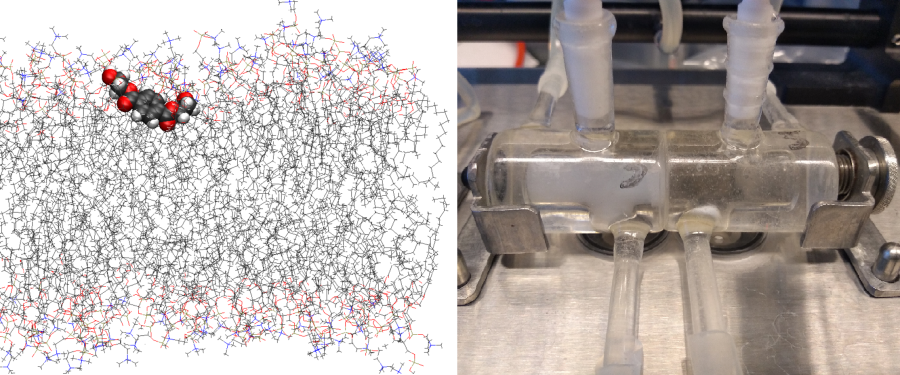Scientists from the University of Eastern Finland employed molecular modeling techniques to analyze the movement of nano-sized plastics in membrane structures. The observations indicate that for certain microplastics, passive transport through the cell membrane might be a significant gateway into the cell.
 The study used molecular modeling of membrane structures and the PAMPA method to study the membrane permeability of microplastics. In the image on the left, the preferred location of PET plastic in the simulation is on the surface parts of the membrane. In the image on the right, the PAMPA method was used to study the movement of plastic across a membrane between two chambers. Image Credit: University of Eastern Finland.
The study used molecular modeling of membrane structures and the PAMPA method to study the membrane permeability of microplastics. In the image on the left, the preferred location of PET plastic in the simulation is on the surface parts of the membrane. In the image on the right, the PAMPA method was used to study the movement of plastic across a membrane between two chambers. Image Credit: University of Eastern Finland.
The microplastics’ occurrence in nature has been studied widely, as well as at the University of Eastern Finland. Yet, knowledge about the health effects of microplastics and their transportation into the human body is limited. Any extreme health effects that are likely linked with plastics might be caused by the plastic compound itself, or through environmental toxins it carries.
Several known heavy metals and fat-soluble environmental toxins have the capacity of attaching themselves to the surface of tiny plastic particles. For the same reason, it is necessary to examine the transportation mechanisms of microplastics into the human body.
However, for the examination of this transport, the research methods developed are very minimal. The lack of standardized methods is another important challenge in microplastics research.
Researchers at the University of Eastern Finland’s School of Pharmacy analyzed the transport and behavior of nano-sized microplastics in bilayer membranes that mimic cell membranes. The team performed simple molecular dynamics simulations with the use of popular and extensively used polyethylene terephthalate (PET) and polyethylene (PE) particles.
The cell membrane permeability of pulverized PET and PE plastics was also analyzed with the PAMPA (Parallel Artificial Membrane Permeability Assay) method. This method is generally used to examine the passive absorption of medicines, but it has not been utilized to study microplastics until then.
The PAMPA method was employed to examine the amount of matter penetrating the membrane. The amount of plastic penetrating the artificial membrane was quantified at specific intervals by NMR spectroscopy.
The molecules’ transportation was managed only by the differences in concentration on different sides of the membrane, and also by an occasional movement that was induced by heat, in both experiments. Put differently, the methods offered data on the passive permeation of molecules via the membranes.
PE particles were identified to prefer the center of the lipid membrane as their position in the computer simulations. In the PAMPA experiments, PE plastic partly infused the membrane, but membrane permeability decreased considerably over time, perhaps owing to the plastic accumulation in the membrane.
In the simulations, the preferred position of PET particles was, to some extent, the surface part of the membrane. Whereas, in the experiments, they penetrated the membrane quite well. As per the study, the features of the membrane structures were not substantially impacted by individual plastics.
The study offers a starting point for the further development of computer simulations and experimental methods, to fulfill the microplastics research requirements. Considerably more data is still required on the active transport of microplastics, such as their sticking to transporter proteins, like phagocytosis, and their toxic impact on cells.
The research was financially supported by the Olvi Foundation and the Doctoral School of the University of Eastern Finland. High-performance computing resources of CSC — IT Centre for Science were employed in the simulations.
Journal Reference:
Järvenpää, J., et al. (2022) PE and PET oligomers’ interplay with membrane bilayers. Scientific Reports. doi.org/10.1038/s41598-022-06217-4.